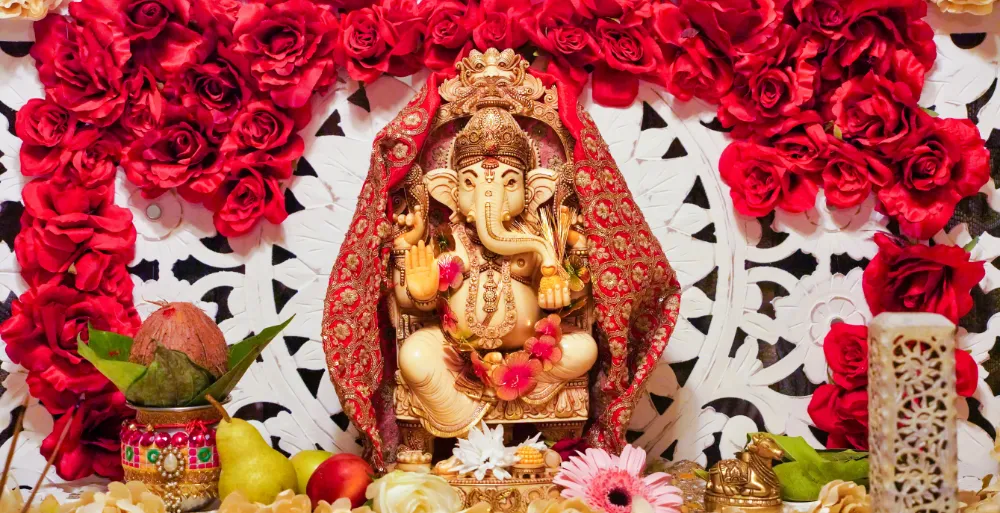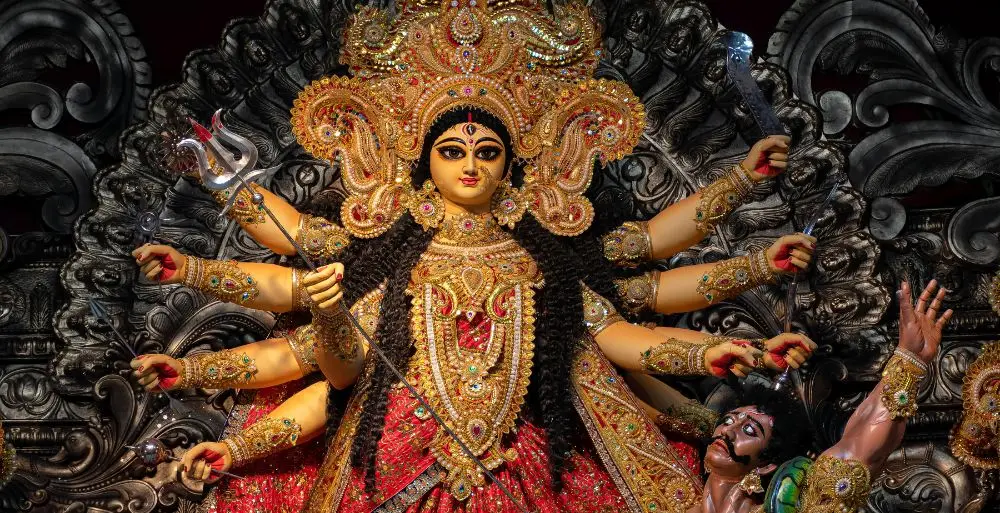Navratri, one of the most revered Hindu festivals, spans nine nights dedicated to worshipping the divine feminine energy in various forms of Goddess Durga. Each day of Navratri is associated with a different manifestation of the goddess, highlighting unique virtues and powers. The 3rd day of Navratri is dedicated to Goddess Chandraghanta, known for her fierce yet compassionate nature, symbolizing courage and the power to dispel darkness.
You can check out our article on the best Navratri dress and Chaniya Choli For Navratri to make your celebration memorable.

Significance of 3rd Day of Navratri

The 3rd day of Navratri honors Goddess Chandraghanta, a fierce and powerful form of Devi Durga. Known for her serene demeanor and the half-moon on her forehead, she embodies strength and grace.
Named for the crescent moon (Chandra) on her forehead, which resembles a bell (ghanta), she rides a lion and carries ten arms with weapons and sacred artifacts, symbolizing her readiness to fight evil forces. Each arm holds weapons and sacred artifacts, symbolizing her readiness to combat evil forces.
She symbolizes peace and strength, reflecting the ideal combination of grace and energy. Devotees believe that the holy sound of her bell repels negative forces and brings peace, prosperity, and spiritual enlightenment.

The Birth of Goddess Chandraghanta: Marking the 3rd Day of Navratri
The story of Goddess Chandraghanta starts with her past life as Parvati, the daughter of King Himavan and Queen Maina. Parvati made many painful sacrifices so that Lord Shiva would love her and let her marry him. Mata Parvati finally reached her goal after years of hard work and devotion, and Shiva agreed to marry her. But on the day of their wedding, Lord Shiva showed up at King Himavan’s palace dressed as a scary ghost and leading a group of ascetics, wild animals, and ghosts.
Shiva’s frightening look, with ash covering his body, a garland of skulls around his neck, and dishevelled hair, terrified everyone present, including the gods and humans. The situation became upsetting and chaotic, which caused a lot of pain for Parvati’s family and friends. Because of what was going on, Parvati changed into the fierce and powerful Goddess Chandraghanta, who had a crescent moon on her forehead that looked like a bell.

The Transformation of Chandraghanta’s Form

Goddess Chandraghanta showed up in a beautiful form, riding a lion and carrying ten different weapons in her arms, including a spear, a mace, a sword, and a bow. Her appearance was both amazing and scary as if she were divinely powerful and in charge.
She talked to Shiva and tried to calm him down. She told him to change into a more gentle form that would work for their marriage. Chandraghanta’s transformation symbolized her role as a mediator and protector, ensuring that harmony and peace prevailed.
When she stepped in, the mood changed. She calmed the guests’ worried hearts and restored balance. Lord Shiva, moved by her courage and understanding, took on a handsome and charming form, and the wedding proceeded gracefully, marking the union of the divine couple.
Also Read: 1st Day of Navratri: Goddess Shailputri Worship Guide

Rituals and Worship Practices on the 3rd Day of Navratri
On the 3rd day of Navratri, devotees perform a series of rituals with great devotion. Key practices include:
Altar Preparation and Decoration
People who worship Goddess Chandraghanta put up an altar with an idol of her. The idol is adorned with red and yellow flowers, symbolizing happiness, health, and holy energy. Surrounding the idol, fragrant incense, diyas (lamps), and other sacred items create a peaceful and auspicious worship space.
Mantra Chanting and Prayers
Chanting mantras dedicated to Goddess Chandraghanta is an essential part of worship. The mantra “ॐ देवी चन्द्रघण्टायै नमः॥” is recited with deep devotion, seeking her protection and blessings. This chanting helps purify the mind, fosters courage, and enhances spiritual awareness.
Offering Prasad to the goddess

People make special food for the goddess, like kheer (sweet rice pudding), sweets, veggies, and coconut. These offerings show appreciation and loyalty. After worship, family members and those in need receive the Prasad, reflecting the spirit of sharing and kindness.
Following the Fast and Devotional Discipline
It is a fast day for many followers, who only eat veggies, milk, or simple meals without grains and spices. Fasting is believed to enhance self-discipline and purity, helping people focus on spiritual goals and worship.
Aarti and singing of love songs
The aarti, a ceremony where devotees wave lit lamps in front of the goddess while singing bhajans (devotional songs), marks the end of the practices. This action implies getting rid of darkness and letting divine light and gifts into your life.

Cultural Celebrations and Festivities
On the 3rd day of Navratri, people across India, especially in Gujarat, Maharashtra, and West Bengal, celebrate with great fervor. They perform traditional dances like Garba and Dandiya to honor the goddess, showcasing joy, unity, and cultural heritage. People dress in vibrant traditional Navratri dress, and temples are adorned with lights and flowers, enhancing the festive atmosphere.
Spiritual Reflection: Lessons from Goddess Chandraghanta
The worship of Goddess Chandraghanta on the 3rd day of Navratri teaches us about the importance of courage, inner strength, and grace. Her fearless nature encourages us to confront life’s challenges boldly, while her compassionate side reminds us to act with kindness and patience.
Navratri is not just a festival; it is a spiritual journey that inspires self-reflection and personal growth. Honoring Goddess Chandraghanta reminds us of the divine power within, guiding us towards righteousness, harmony, and inner peace.
Also Read: 2nd Day of Navratri: Worship Guide for Maa Brahmacharini

Conclusion: Embracing the Divine Feminine Energy on 3rd day of Navratri
The 3rd day of Navratri, dedicated to Goddess Chandraghanta, is a powerful reminder of the resilience and divine qualities that lie within every individual. Through her worship, devotees seek to harness these attributes, overcoming negativity and embracing a life of spiritual fulfilment. Navratri, in its essence, celebrates the triumph of good over evil and the eternal presence of the divine feminine energy that sustains the universe.





